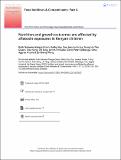Nutrition and growth outcomes are affected by aflatoxin exposures in Kenyan children

Publication Date
2020Author
Ruth Nabwire Wangia-Dixon a , Kathy Siyu Xuea , Jessica Alcalaa , Trang Ho Thu Quachb , Xiao Songb , Lili Tanga , James Ombakac , David Peter Githangad,e, Omu Aggrey Anzalae,f, and Jia-Sheng Wang
Metadata
Show full item recordAbstract/
Aflatoxin exposure, malnutrition and growth impairment in children present significant public
health problems in low- and middle-income countries. Recent epidemiology studies show that
exposure to aflatoxins through dietary sources in early life contributes to growth retardation among
children. However, the findings remain inconclusive due to limited comparative studies in high
versus low aflatoxin exposure regions. This cross-sectional study presents aflatoxin exposure levels
among children aged 6 to 12 years, and further evaluates the association between aflatoxin
exposure levels, malnutrition and growth impairment in Kenya, East Africa. AFB1-lysine adducts
are validated biomarkers of exposure and were quantified using HPLC with fluorescence detection.
All children (n = 746) had detectable levels of AFB1-lysine adducts in serum, range 0.65–518.9 pg/
mg albumin with a geometric mean (GM) of 10.5 (95%CI 9.4–11.7) pg/mg albumin. The Geometric
Means (GM) of AFB1-lysine adducts were 14.0 (95%CI 12.5, 15.7) pg/mg albumin and 8.2 (95%CI 7.6,
8.8) pg/mg albumin (p-value < 0.001), among children recruited from Makueni and Siaya Counties,
respectively. While the study confirms higher human exposure levels in Makueni county, it provides
an initial data set for aflatoxin exposure levels among children recruited from Siaya County. In
multivariate analysis, after adjusting for socio-economic indicators, farming practices, and household dietary patterns, increasing one unit of log AFB1-lysine was associated with decreasing Weightfor-age z-score (WAZ) by −0.13, p-value = 0.019 among all children aged 6–12 years. Among
children 6 to 9 years, WAZ decreases by −0.11 (−0.54, −0.01), p-value = 0.049. Additional growth
parameters Height-for-age z-score (HAZ) and Weight-for-height z-score (WHZ) do not reach statistical significance. HAZ decreases by −0.08, p-value = 0.337 and WHZ decreases by −0.17,
p-value = 0.437 with every increase in log AFB1-lysine. These data suggest that efforts must be
put in place to control for aflatoxin exposure in order to achieve better growth outcomes
